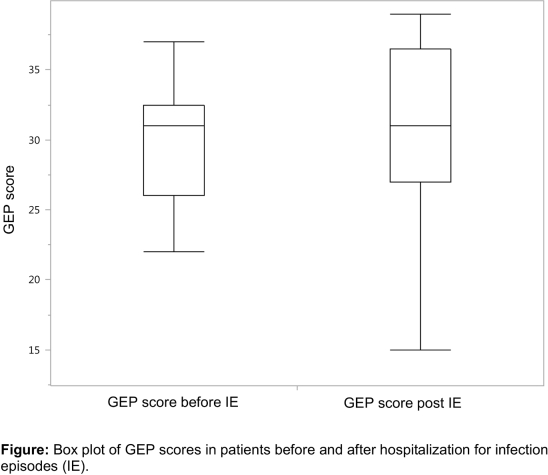Gene Expression Profiling Score and the Risk of Infection in Heart Transplant Recipients.
1University of Pittsburg, Pittsburgh, PA
2Intermountain Medical Center, South Lake City, UT
3Baylor University Medical Center, Dallas, TX
4Cedars-Sinai Heart Institute, Los Angeles, CA.
Meeting: 2016 American Transplant Congress
Abstract number: B158
Keywords: Gene expression, Heart transplant patients, Immunosuppression, Infection
Session Information
Session Name: Poster Session B: Hearts and VADs in Depth - The Force Awakens
Session Type: Poster Session
Date: Sunday, June 12, 2016
Session Time: 6:00pm-7:00pm
 Presentation Time: 6:00pm-7:00pm
Presentation Time: 6:00pm-7:00pm
Location: Halls C&D
Purpose: This study assessed the association of gene expression profiling (GEP, AlloMap®) score with infections in heart transplant recipients (HTR). Although a GEP score below threshold is used to rule out acute cellular rejection at the time of testing, we hypothesize that low GEP scores may also indicate over-immunosuppression leading to hospitalization for infection.
Methods: Patients hospitalized for infectious episode (IE) were identified from 596 HRT who received 2171 GEP tests as part of standard of care rejection surveillance in the ongoing Outcomes AlloMap Registry (OAR). Patients with IE were included if they had GEP scores ≤62 days prior to and ≥1 GEP score after an IE. Scores were analyzed using non-parametric statistical methods. Because cytomegalovirus (CMV) infection has been shown to be associated with higher GEP scores, the 8 CMV infections were excluded. The control patients were chosen after adjusting for time post-transplant.
Results: Out of a total of 182, 42 (23%) hospitalizations were reported for IE in 38 patients at a median of 300 days (157 to 373, 25-75% quartile) post-transplant. Of these, 13 IE (in 12 patients) were included. A GEP test was obtained at a median of 42 days (21 to 62) prior to and 19 days (8 to 45) after the IE. The causes of IE are shown in the Table. The median GEP score prior to IE was 31 (26-33); the median GEP score after IE was 31 (27-37), P=0.3155 (Figure). In time matched control patients (n=189) who had no IE, the median GEP score was 29 (25-32).
Conclusions: This exploratory small sample study suggests that GEP scores were not lower thus did not indicate an over-immunosuppressed state prior to IE. Analyses on a larger sample size and considering GEP scores obtained within 30 days of the infection episodes from the ongoing OAR are of future interest.
| Cause of infection | n |
| Influenza | 3 |
| Clostridium difficile | 2 |
| Other viral (not CMV) | 2 |
| Other bacterial | 1 |
| Aspergillus | 1 |
| Not reported | 4 |

CITATION INFORMATION: Teuteberg J, Budge D, Shullo M, Hall S, Kobashigawa J. Gene Expression Profiling Score and the Risk of Infection in Heart Transplant Recipients. Am J Transplant. 2016;16 (suppl 3).
To cite this abstract in AMA style:
Teuteberg J, Budge D, Shullo M, Hall S, Kobashigawa J. Gene Expression Profiling Score and the Risk of Infection in Heart Transplant Recipients. [abstract]. Am J Transplant. 2016; 16 (suppl 3). https://atcmeetingabstracts.com/abstract/gene-expression-profiling-score-and-the-risk-of-infection-in-heart-transplant-recipients/. Accessed December 27, 2025.« Back to 2016 American Transplant Congress
